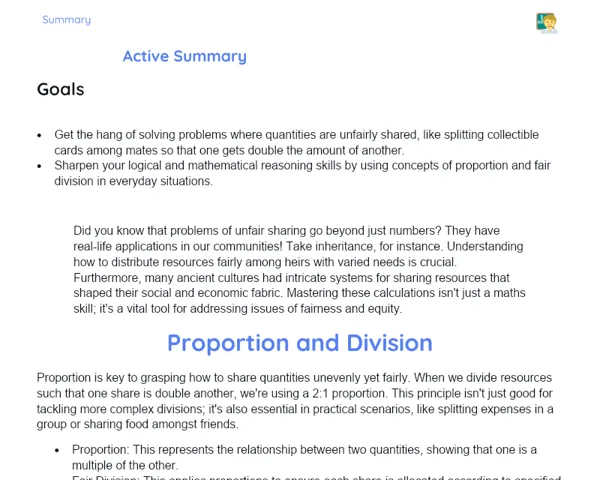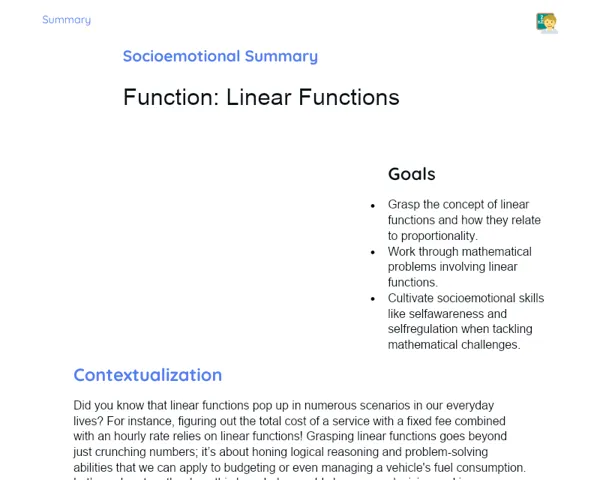Summary Tradisional | Geometric Progression: Terms
Contextualization
Geometric Progression (GP) refers to a numerical sequence where each term, after the first, is found by multiplying the previous term by a constant known as the common ratio. This concept is crucial for grasping various real-world phenomena, such as population growth, financial mathematics, and biological processes. For instance, in a sequence such as 1, 2, 4, 8, ..., the common ratio is 2, since each term is double that of the previous one. GPs are relevant in diverse contexts, from bacterial growth to calculating compound interest in savings.
Grasping Geometric Progression is key for tackling problems associated with exponential growth and decay. In finance, compound interest relies on GP, whereby the sum increases geometrically over time. Similarly, GPs play a role in biology, particularly in modeling the reproduction rates of organisms and predicting population increases. By understanding how to derive the terms of a GP and its characteristics, learners can apply this knowledge across various fields, enhancing their ability to solve complex challenges and make informed choices.
To Remember!
Definition of Geometric Progression (GP)
A Geometric Progression (GP) is a sequence where each term, from the second one onward, is produced by multiplying the previous term by a constant called the common ratio. This ratio remains unchanged throughout the sequence. For example, in the sequence 1, 2, 4, 8, ..., the ratio is 2, illustrating that each term is double the one before. GPs are foundational in understanding exponential growth, particularly in finance and biological applications.
Knowing the definition of GP is vital for identifying and working with these sequences in mathematical contexts and real-life scenarios. The common ratio can be any real number, including fractions or negative values—this directly impacts how the sequence behaves. A positive ratio greater than 1 signifies growth, while a ratio that falls between 0 and 1 indicates decay.
Moreover, GPs underpin more advanced mathematical concepts. For example, in finance, compound interest calculates according to a GP, showing how money grows geometrically over time. In biology, the reproduction of species can be depicted using GPs, facilitating predictions of population dynamics. Thus, the knowledge of GP is foundational across numerous disciplines.
-
GP is a sequence where each term is derived by multiplying the preceding term by a constant ratio.
-
The common ratio can be any real number, including fractions and negative values.
-
A solid understanding of GP is essential for addressing issues involving exponential growth and decay.
General Formula of GP
The formula to calculate the n-th term of a Geometric Progression is expressed as: a_n = a_1 * r^(n-1), where a_n denotes the n-th term, a_1 is the initial term, r represents the common ratio, and n indicates the term's position in the sequence. This formula is instrumental for determining any term without having to compute all previous ones.
To use the formula effectively, one must know the first term and the common ratio. For instance, in the sequence 3, 6, 12, 24, ... where 3 is the first term and the common ratio is 2, the sixth term can be derived: a_6 = 3 * 2^5 = 96. Mastery of the general formula allows for quick and efficient problem-solving.
The GP formula also extends to more complex scenarios, such as when addressing infinite series and financial assessments. For example, it’s used to calculate an investment's future value in compound interest scenarios. Therefore, being proficient in the general formula is crucial for practical and advanced applications.
-
The general formula of GP is a_n = a_1 * r^(n-1).
-
This formula enables us to find any term without recalculating all the previous terms.
-
Familiarity with the formula is vital for efficient problem-solving, especially in complex scenarios.
Properties of GP
The characteristics of Geometric Progression help us understand how the sequence behaves in relation to the common ratio. If the ratio exceeds 1, the sequence grows exponentially, such as in 1, 2, 4, 8, .... When the ratio lies between 0 and 1, the sequence shows exponential decay, as in 16, 8, 4, 2, .... If the ratio is negative, the sequence alternates signs, for instance, 1, -2, 4, -8, ....
Another notable attribute is how consecutive terms relate. In a GP, any term can be calculated by multiplying the preceding term by the common ratio. This means that with knowledge of the ratio and any single term, one can derive the rest of the sequence. This property streamlines the analysis and manipulation of GPs in both mathematical and practical contexts.
Additionally, the sum of the terms in a finite GP also has specific formulas, useful for a variety of applications, such as in the study of series. For instance, the sum of the first n terms of a GP is indicated by S_n = a_1 * (r^n - 1) / (r - 1), provided that r ≠ 1. A comprehensive understanding of these properties is vital for an in-depth analysis of GPs.
-
The common ratio influences the behavior of the sequence (growth, decay, or sign changes).
-
Any term in the sequence can be derived by multiplying the previous term by the common ratio.
-
The sum of the terms in a finite GP has specific formulas applicable to various scenarios.
Applications of GP
Geometric Progression has several practical applications across different disciplines. In finance, for instance, GP is key for calculating compound interest, where an investment's value grows exponentially over time. The GP formula allows one to determine the overall amount in savings or long-term investments.
In biology, GP aids in modeling population growth. Species that reproduce at steady rates can be illustrated as a GP, making it easier to predict their numbers over time. This is particularly beneficial in ecological research and species management.
Additional applications of GP are seen in engineering and physics, where processes of doubling and decay can be modeled using these sequences. For instance, when evaluating electrical circuits or assessing the half-lives of radioactive materials, GPs become a vital tool for forecasting and modeling behaviors.
These real-world applications underscore the importance of comprehensively understanding GP, enabling learners to leverage this knowledge effectively in various contexts and tackle intricate problems with ease.
-
GP is essential for calculating compound interest in finance.
-
In biology, it serves to model population growth.
-
In engineering and physics, GP is applied to model processes such as doubling and decay.
Key Terms
-
Geometric Progression (GP): A numerical sequence where each term is attained by multiplying the previous term by a common ratio.
-
Common Ratio: The fixed number by which each term of the GP is multiplied to yield the subsequent term.
-
General Term: The formula used to compute any term of the GP: a_n = a_1 * r^(n-1).
-
Exponential Growth: The behavior of a GP where the ratio exceeds 1, leading to rapid sequence growth.
-
Exponential Decay: The behavior of a GP when the ratio ranges between 0 and 1, resulting in a sequence reduction.
-
Alternation of Signs: In a GP with a negative ratio, the terms alternate between positive and negative values.
-
Compound Interest: A financial calculation grounded in GP, where the total grows exponentially through time.
-
Population Growth: A biological model utilizing GP for predicting increases in organism populations.
-
Sum of the Terms: The formula for summing the first n terms of a finite GP: S_n = a_1 * (r^n - 1) / (r - 1), when r ≠ 1.
Important Conclusions
Understanding Geometric Progressions (GP) is vital for comprehending the behavior of numerical sequences where each term derives from multiplying the preceding term by a constant ratio. This concept is fundamental in many fields, including finance, biology, and engineering, especially where exponential growth and decay phenomena frequently occur. By familiarizing oneself with the properties of GPs, such as the general term formula and its growth or decay characteristics, one can efficiently analyze and tackle complex problems.
The standard formula for GP, a_n = a_1 * r^(n-1), is a powerful resource for determining any term without recalculating those preceding it. This knowledge finds practical application in contexts like computing compound interest and modeling population dynamics, accentuating the relevance of GPs in everyday life and informed decision-making. A thorough understanding of these properties and utilization of the general term is crucial for effective analysis and problem resolution across various fields.
Moreover, the real-world applications of GPs, be it in predicting population trends or calculating compound interest, shed light on the importance of this mathematical concept for discerning natural and economic trends. The proficiency to leverage and apply GP knowledge enables students to resolve intricate issues, forecast outcomes, and make informed choices, emphasizing the relevance of studying geometric progressions in both daily and academic settings.
Study Tips
-
Review the definition and characteristics of Geometric Progressions, especially focusing on the ratio and sequence behavior.
-
Practice using the general formula of GP (a_n = a_1 * r^(n-1)) across various problems, encompassing both financial and biological applications.
-
Engage with practical scenarios and everyday examples involving GPs, like calculating compound interest and tracking population growth, to strengthen understanding and application of the concept.



